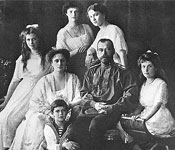Exhibition Shows Russian Leaders, From Romanovs to Putin

(Moscow Times – themoscowtimes.com – D. Garrison Golubock – November 20, 2013) Moscow has a reputation for lines, yet even seasoned city dwellers were surprised to see the massive lines that formed in the first week of November in front of Manezh, snaking all the way to the State Historical Museum and then back around the other side of Manezh Square.
For the past two weeks, Muscovites have been lining up in their thousands and standing in line for hours in increasingly cold weather to see “The Romanovs. My History,” a free historical exhibit on display at Manezh in honor of the 400th anniversary of the beginning of the Romanov Dynasty.
Organized by the Russian Orthodox Church, The City of Moscow, and the Ministry of Culture, the exhibit was highly anticipated prior to the public opening on Nov. 4. Prominent ads were placed throughout the Moscow Metro and on billboards throughout the city, while an intensive PR effort attempted to spread announcements throughout the media.
At first glance, the exhibit seems like something of a gamble: Manezh is the most expensive and most prominent exhibition space in Moscow, and historical exhibits are frequently dry and boring, attracting few viewers. However, the organizers spent lavishly not only on PR efforts but also on the exhibit itself, incorporating the newest technologies and festooning the immense space of Manezh with giant flatscreen televisions and computers, immense color tapestries, and frequent video projections. Apart from the quality of the exhibit, the organizers also made the exhibit free, thereby ensuring a steady stream of visitors.
Both President Putin and Patriarch Kirill were present at the opening ceremony on Nov. 4, and since then as many as 13,000 people have visited the exhibit every day, including as many as 35 school groups daily. A quick glance at the line outside Manezh shows that the visitors come from all walks of life: students and pensioners, Muscovites and tourists. Though originally intended to run only for one week, the exhibit has now been extended until Nov. 26 and will be open every day until midnight.
However, while the exhibit has drawn crowds of visitors, it has also been criticized in the media, with many observers commenting on the highly politicized and nationalist history presented to viewers. Some have noted the crowds of Orthodox priests stationed throughout the exhibit to monitor viewers and answer questions, while others have complained about the role of President Putin, whose portrait is prominently placed at the end of the exhibit, almost appearing to be the next Romanov tsar.
Culture Minister Vladimir Medinsky was quite upfront about the political aspects of the exhibit: “The use of this exhibit, of course, is not only educational, not only promotional, but also it seems to me this exhibition has a political use. It raises many important questions and gives a fantastic collection of quotes and opinions,” Medinsky said to RIA Novosti.
The exhibit begins with “Time of Troubles” and the coronation of Mikhail Romanov in the 15th century and follows through to the Russian Revolution in 1917, devoting a room to nearly every Romanov tsar. Some common threads seem to be the gradual expansion of Russia’s borders and population and the overall development of Russia. The actions of the tsars appear to be the natural path of Russia, a constant trajectory leading towards greater and greater things.
Consequently, those who attempted to divert Russia from this path are portrayed in an unfavorable light. The exhibit devotes some displays to these “enemies of Russia” these are easily noticeable as they are all darkly lit and put on blood-red and black backgrounds, with words like “usurpers,” “bandits,” and “foreigners” scattered amidst the portraits of these repulsive individuals, who include Decembrists, Polish monarchs, and Ukrainian separatists, among others.
Near the end of the exhibit, signs trumpet the many feats that Russia reached under Nikolai II, the last emperor, describing it as “the highest point in the development of the Russian Empire.” Quotes highlight the rapid growth of industry and population, speculating as to the miraculous things that might have happened if his rule had continued uninterrupted.
And then, everything goes bad: Lenin and Stalin appear, skulking in the corners of lurid red displays like all the other villains and enemies, and photos of ruined churches and warfare replace the visions of happy peasants and the Romanovs.
In the final section of the exhibit, a projector plays video clips of post-Soviet Russia. Scenes of criminals and hooligans, the White House in flames, poverty and terrorism. Finally, an image of Vladimir Putin gazing determinedly forward flashes across the screen, and once again we see happy families and new malls being built all is well again in Russia.
While the exhibit may not be the most reliable source of historical information, the extensive use of technology and lavish funding have created a highly entertaining exhibit. Now extended for yet another week, there is still plenty of time to see it, for those who are prepared to face the lines.
“The Romanovs. My History” will run until Nov. 26 at Manezh, 1 Manezh Square. Metro Okhotny Ryad.
